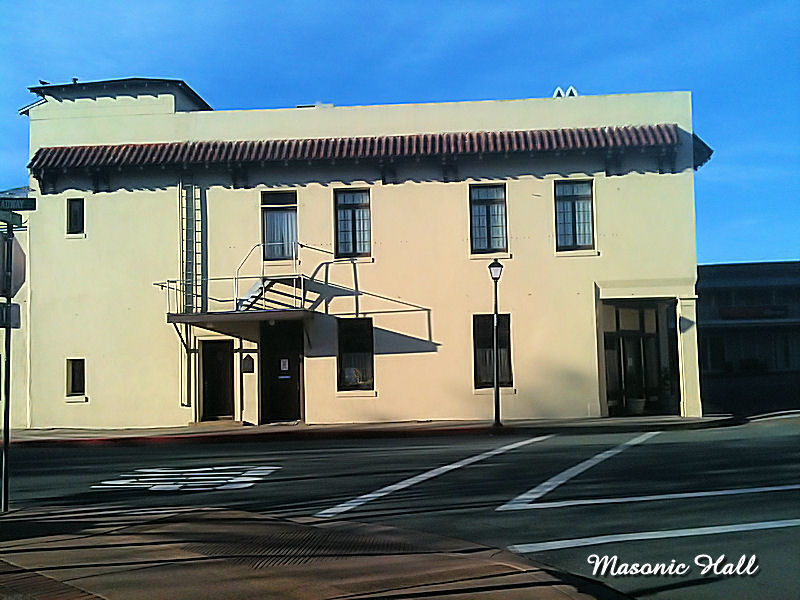





|
|
Jackson's Masonic Hall, Jackson, California | ||
|
An acquaintance and Mason commented recently, about a the piece on the cornerstone with Masonic symbol in Moses Moses Bruml's store - the BottIe Shop now. Having heard before that tIle original Masonic lodge was on that side of the street, he wondered if Bruml's place wasn't it. Logan doubted that the lodge was ever at that location but knew the original lodge had been across the street. But Moses Bruml (or Brumel), a Mason himself, was, at one time, the order's landlord. |
|
|
Then the acquaintance whetted Logan's historical curiosity by alluding to the lodge's first treasurer's book, dating back to 1854, still preserved. Logan naturallt expressed a desire to peruse the ledger. Given assurance he could, he assures the reader he will. That way we'll learn the charter membership few more facts about "Amador Lodge No. '65 F.& A.M."to go with the few details his notebooks contain. There is considerable information in the lodges centennial booklet published in 1954. The writer scanned it briefly but has no copy before him. Those annals tell you some of what he will relate here. The lodge's original minute book - is it lost now? - was extant then and the author of the booklet could that primary source. ...Logan knows the Sacramento Union refers to Jackson's new lodge (and the county's second, after Volcano); a couple of times in late 1854. The first mention, October 30, tells that a new lodge is being organized; the second, on November 22, reports the lodge was organized on November 13, 1854. About the same time the lodge was being organized, member Bruml was having built, on the site of Frank Hoffman's old livery stable and corrals, a two-story Brick building. Possibly Bruml already had the lodge's assurance it would rent part of it before he decided to construct it. Regardless, in November Bruml's proud brick stood at the corner of Court and Main. From the second floor window one could lean out and see workmen constructing the new court house atop "corral hill." One copy of an 1854 issue of an Amador paper survives. The Amador Sentinel, December 30, published in Jackson, reads: "Masonic Notice. The next regular communication Amador Lodge, F&AM, will be held at Masonic Hall, corner of Main and Court Streets, Jackson, on Tuesday ening, January 2, 1855. Members of the Order are invited to attend. Bruce Husband, Sec'y." We learn, too, from that issue that the lodge was sponsoring a ball on February 22 to celebrate the birth one illustrious departed member. That the lodge stayed there through 1857 is indicated by a drawing of Bruml and company's building, which Logan has a copy. The Masonic symbol appears on the second floor, front. Most likely the lodge remained in that building (Corner Court and Main) until its removal to today's Masonic building prior to the 1862 fire. It was a prescient move: the old hall was gutted and its walls pulled down while the new hall, Frank Rocco's two-story brick the southwest corner of Broadway and Water, survived. The Masons rented the second floor. The building, incidentally, was probably built in the spring of 1854. If not, why did owner George Stevens or mortgage the property to AC. Brown in May, , for $800, and in October sell it to Perry and Graham for $2,700. The disparity in price surely meant the new, twobrick building was standing there then. The building housing the lodge initially was built in 1854 with poor quality cement. Its walls stood quaking when most of the town was ashes and rubble. We read "the Chief Engineer ordered the walls of Steckler and Newbauer's building... to be pulled down...." I should judge," wrote a contemporary in a letter Francisco's Spirit of the Times, "that in the construction ... at least two barrels of cement were used..., a perfect counterfeit on the name of 'fire-proof." The letter writer also credits Mokelumne Hill citizens with arriving in time to "save the houses of Coney and Axtell (on Broadway)" and "save the nice building in town." They or someone did. The building survived with some damage. Sacramento Union reported that "F. Rocco's story brick was slightly damaged, also tile Masonic upstairs." Damage ran to $4,000 for Rocco and $3,000 for the lodge. The lodge, a renter before the fire, became an owner soon after. A deed dated August 26 conveyed, for $2,000 "all that second story now finished of that brick building ... and a suitable platform stairway and stairs." Rocco had obtained the whole building in 1859 for only $1,250, so post-fire prices were naturally higher. While the deed says the lodge bought the second story three days after the fire, minutes of the board of supervisors show the board met with lodge trustees two days after the fire and verbally agreed for the county "to have use of their hall over Frank Rocco's store for county purposes." Crowded into the second floor were the records and offices of clerk Bicknell, sheriff Cosner and treasurer McGrath. For its court and jury rooms, the supervisors also leased the first floor from Rocco. Presumably - the word hints that Logan hasn't checked it out - the county officers remained in the lodge until the new court house was ready in late December, 1863, or early January, 1864. Presumably again the lodge met in the second floor of the new Steckler building at Court and Main. One of the local papers carried a notice to that effect in April, 1863. It looks like the lodge moved back in when the county moved out in early 1864, and has been there since. It has long since bought the whole building. Apparently, OUT 120-year-old order (121 soon) has had two lodges, the first at Court and Main, and the second and present at Broadway and Water. Logan won't count that place it met during those few months when one lodge was being used by the county, and the other was being rebuilt. For what may be the town's oldest, continously active institution (the water company is old, too) it is fitting it inhabits what seems to be the town's oldest brick building. They were both born in that memorable year, 1854. |
||
Return to our Jackson Tour or click on our Minor to end your tour 
|
||
Information, photographs courtesy of the Amador County Archives, The Historical Marker Database, The Chronicling America Database, and Larry Cenotto, Amador County's Historian CONTACT US
|
||
